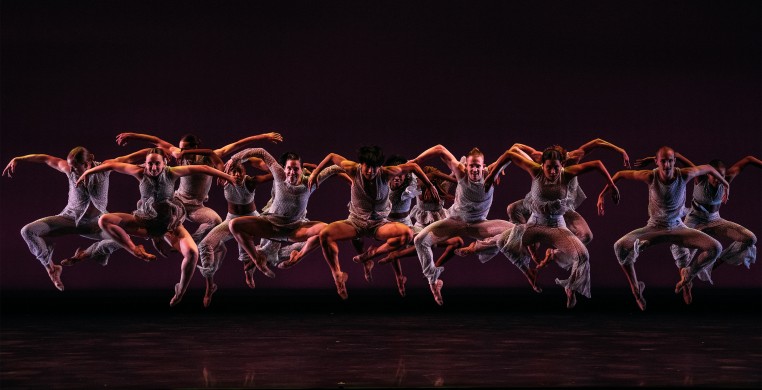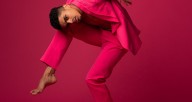Hubbard Street Dance Chicago’s summer season, “Facets,” at Chicago’s Harris Theater (May 18-21) opened with Randy Duncan’s "Love Infinite (2022)," setting a breezy tone for the entire evening with a joyful celebration of the power of love to heal the world.
Set to composer Ira Antelis’ music of the same name, with the poetry and spoken words of I sadat's, "Love Infinite" introduces us to Hubbard Street’s newest roster of dancers under the visionary artistic direction of Linda-Denise Fisher-Harrell.
Denise has come full circle with Hubbard Street, just in time to rescue a company that was decimated by the loss of its home and school, the pandemic, and the flight of dancers to places elsewhere.
Denise, who began performing with Hubbard Street at the age of 19, left Chicago for a 13-year stint as a leading dancer with Alvin Ailey, then graduate school, and balancing full-time teaching and family. Now, two years at the helm of the company that launched her career, her leadership and vision are manifest on stage.
In an interview with SeeChicagoDance last winter (Reference: SeeChicagoDance.com, March 27, 2023), Denise described her agenda for the upcoming season, and for the company, as respecting and honoring the company’s 45-year legacy and forging new directions for the future.
“Facets” proved just that, with a perfectly-constructed program of four distinctively different choreographic palettes that played like a gem on “facets” of the same theme: the joy of life and love. Thank you for reminding us, at a time of local, national, and global conflict, how supremely suited the art of dance is to celebrate what is most noble in our collective humanity.
The lyrical flow of Duncan’s Love Infinite flooded the stage with balletic lifts, rapid chaîné turns, and swift runs across the stage, all to the rhythmic beat of inspirational words like “Respect Life” and “World Unite.” Balletic brisés and entrechats mixed with Afro-Caribbean social dance moves. Jet-propelled flights of grands jetés soared as earth-bound foot stomps grounded dancers in the source of life’s sustenance. “We need Love” accompanied double pas de chats and pirouettes. Lighting designer Dustin L. Derry’s smokey rainbow of light rose above while a speckled light pattern carpeted the stage floor in a dreamlike effect that suggested hope for a future of peace. From the get-go, Love Infinite assured the audience that we were in the hands of world-class artists showcasing their impeccable technique, virtuosity, and interpretive sensibility.
Not to be minimized, a hallmark of Hubbard Street over the past 45 years is that each dancer brings a uniquely individual presence to the stage, and yet with such acute sensitivity to each other that they become a vibrant team, so “in the moment” that you witness the performance as an act of spontaneous creativity.
Following intermission, Lou Conte’s duet, Georgia (1987), originally choreographed for Claire Bataille (1952-2018) and dedicated to her, evoked the mourning of two past relationships—one a man’s bittersweet memory of what might have been, and the other the choreographer’s homage to Claire. Program notes quote Conte as saying, “It’s very probable there would not be a Hubbard Street Dance Chicago had it not been for Claire Bataille.” Set to the music of Hoagy Carmichael, the lyrics, “Georgia on my mind,” blend Carmichael’s music with the visual landscape of Robert Christen and Todd Clark’s lighting design, poetically rendering Georgia as a place, a time, and a person.
 Claire Bataille and Ron De Jesus in Georgia by Lou Conte, 1987
Claire Bataille and Ron De Jesus in Georgia by Lou Conte, 1987
Real-life husband and wife, Jacqueline Burnett and David Schultz, gave us a nuanced and psychologically complex, two-part character study. In the first, a solo, Burnett shows us a sensual woman in conflict with herself. Her vulnerability contrasts with her strength, the flow of softness and sensuality with the broken tension of angular arms and gestures that slash across her body; someone who might be a liability to herself and a little dangerous for any partner. Burnett’s exquisite arms project volumes of emotional context. Schultz’s entrance immediately casts constraint on her sensuality and promises to tame her edginess. Their duet changes the temperature. He partners her with authority and tenderness, from which she ultimately rebels, leaving us to assume that, recalling what might have been, he still loves her.
Lar Lubovitch’s Coltrane’s "Favorite Things," reprising its March, 2023 premiere, returns us to carefree joy. Clad in yellow sneakers and yellow or gray tops, the company could be a bunch of school kids set loose on the playground for recess on the first balmy day of spring.
Their movement is the “happy talk” of delight, discovery, and shrieks of kids’ laughter. Breathy and full of gorgeous suspensions, their arched spines and high-releases dive headlong to the floor. They peel off in cannons and reconvene in ensemble formations. Swift partner exchanges, plunges, deep dips, and upside-down lifts keep the action moving non-stop.
A giant Jackson Pollack “drip canvas” covers the entire upstage wall and unites Coltrane’s musical carbonation with the dancing mirth below. Piano jazz and drum riffs mirror and propel the dancers in a fizz-pop of arpeggios and driving rhythms, calling the dancers out from the wings as if uncorking champagne bottles. A trio of dancers, Elliot Hammans, Simone Stevens, and Jack Henderson go “cray-zee” with flexed-foot be-bop splits and 40’s-style swing dance moments, go-for-broke movement that shouts, “Whoopee!” This piece is a marathon of endurance for a company that seemingly has energy to spare.
Closing the program was Rennie Harris’s world premiere, Dear Frankie. Set to House Music, composed by Harris and Darrin Ross, we are drawn back to where it all began on the streets and in the houses of Chicago’s south side. An homage to the “godfather of House Music, DJ, Frankie Knuckles,” the piece begins with a molten mass of bodies “en scène,” and the words, “thank you for setting me free,” igniting a sequential peeling off of individuals.
Walking, both pedestrian and slo-mo, they look around as if just hatched from extra-terrestrial eggs. A searchlight finds one, then another. Some get stuck in the spotlight and quake, as if having a seizure. They spin on the floor and recover to a perpetual-motion revel. Percussive, earth-bound beats, upper body pulsing, and mind-boggling body isolations characterize the non-stop movement.
Tangles of super-fast, foot-knitting choreography tie legs into improbable knots, from which they escape into an occasional full-body yawn and plenty of attitude. Disco lights flash, pushing the frenetic pace to the limits and an ending that electrocutes the stage with a bang, leaving both audience and dancers in breathless blackout. What a night!!


